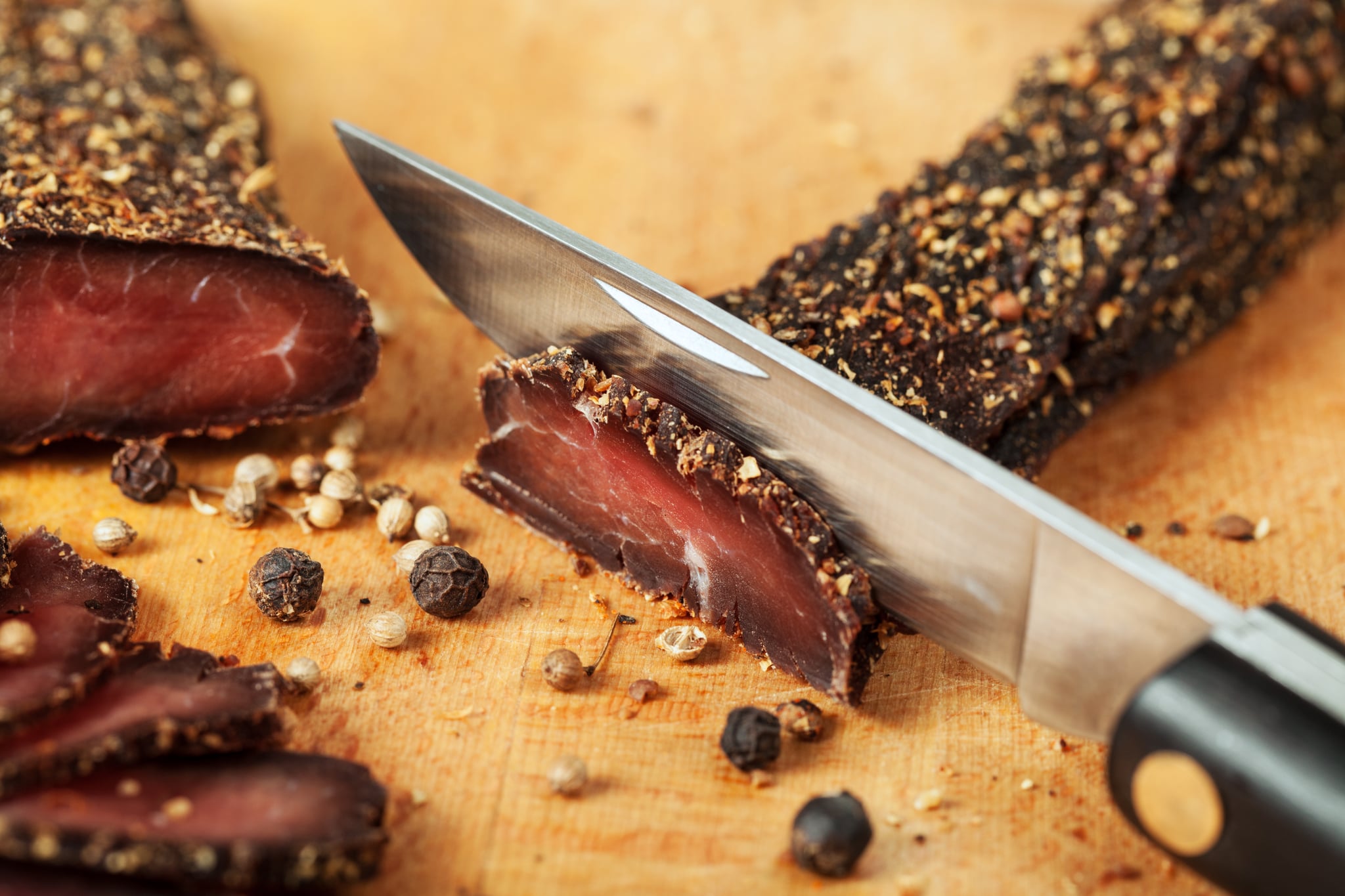Products You May Like
Lately, you may have noticed beef biltong popping up on more store shelves. The dried meat treat has long been a staple in South Africa, and it’s become a beloved option in the US, too. Meat-based bites in general have become more popular in recent years, and biltong in particular appeals to anyone who’s looking for a high-protein snack without a ton of additives.
If you don’t know what biltong is, it’s most often likened to jerky, which is understandable, since the two foods look the same — but that comparison doesn’t really do biltong justice. Here, find everything you need to know about this savory option, from what biltong is, to what makes it different from other similar foods, to what its nutritional benefits are.
What Is Biltong?
Imagine taking tender slices of beef and marinating them in a mix of vinegar, salt, and spices. Then, rather than cooking them, these seasoned strips are hung to air-dry gently, allowing flavors to deepen and mature, typically without any sodium nitrates or nitrites (preservatives other meat snacks may use for shelf life, flavor, and color).
While the Indigenous people of South Africa air-dried and cured their meat to preserve it, the name biltong comes from the Dutch words “bil” (buttock) and “tong” (stripe or tongue), meaning “strip of meat.” Dutch settlers in South Africa introduced spices like pepper, coriander, and cloves to biltong, which are still commonly used to make it today.
While biltong can be made from a variety of meats, the options you see on store shelves tend to be beef biltong. The snack fits into many diets that emphasize protein, but it’s really an option for anyone who wants a filling, tasty, grab-and-go snack.
How Is Biltong Different Than Jerky?
In the realm of dried meats, biltong and jerky might seem like long-lost cousins, but they have notable differences.
Biltong and jerky are both forms of dried meats, but their origins, preparations, and tastes are distinct. Biltong, which hails from South Africa, is made from large cuts of meat that are seasoned with vinegar, salt, and various spices before being air-dried for weeks. Traditional biltong doesn’t use nitrates or nitrites.
Jerky, on the other hand, has North American roots. It’s traditionally made from thinner slices of meat that are marinated, smoked, or dehydrated at a low temperature for a shorter time. While recipes for jerky can vary, many commercial jerky products are made with nitrates or nitrites, which act as preservatives, helping prevent the growth of bacteria and prolonging the shelf life of the food. (Nitrate-free jerky is available, too; it uses natural alternatives such as celery powder.) Jerky is also often made with sugar, while biltong is sugar-free.
Taste-wise, biltong tends to be more savory, while jerky often has a smokier, sometimes sweeter flavor profile. Biltong is also cut against the grain of the meat, which, combined with the air-drying, makes for a softer, chewier texture to jerky’s leaner, tougher chew.
Biltong Nutrition
Biltong is renowned for its rich nutritional profile, particularly its high protein content. While the curing process jerky goes through can cause some of its protein to denature, biltong loses weight but not protein in its drying process. As a result, it’s an excellent snack option for those looking to maintain or build muscle mass.
Biltong is also low in carbohydrates, aligning well with ketogenic and other low-carb diets — or just allowing you to pair it with the carb source of your choice for a more customized snack. Plus, the curing process removes much of the moisture from the meat, resulting in a concentrated source of vitamins and minerals such as iron, zinc, and B vitamins.
However, being a cured product, biltong can also be high in sodium, which should be consumed in moderation, especially for individuals with hypertension or heart conditions. As with all foods, moderation is key, and biltong can be part of a healthy, balanced diet when consumed conscientiously.
How to Enjoy Biltong
Biltong can be eaten on its own, but it also pairs wonderfully with other foods. Try adding it to a cheese board, chopping it and sprinkling it over salads to add a protein boost, or using it as a flavorful topping for baked potatoes or pizza. You can also incorporate biltong into omelets, quiches, or soups to give these dishes a unique twist (and a protein bump).
While it’s possible to make biltong on your own, the process can take up to a week. Luckily, there are more store-bought options available these days. Try brands like Kalahari Biltong ($10), Stryve Beef Biltong ($8), and Brooklyn Biltong ($39 for a pack of five), which are available at many grocery stores and online.
